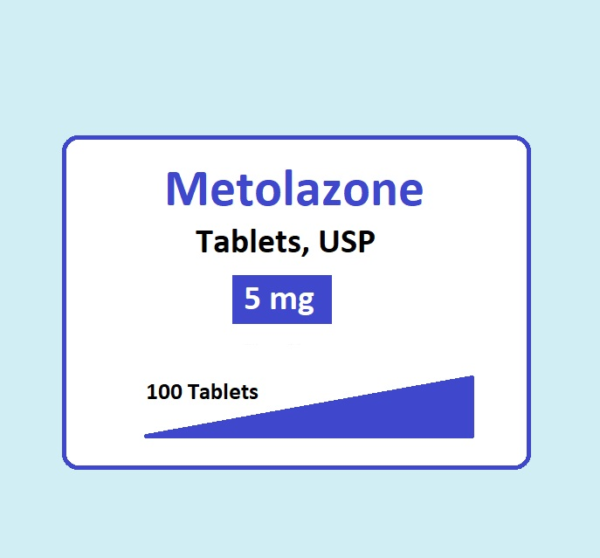A thiazide diuretic medication called metolazone (Zaroxolyn) is used to treat the symptoms of edoema brought on by renal and heart failure.
Metolazone Indications:
-
Edema:
- Metolazone is used to treat edoema brought on by heart failure or renal disorders, such as nephrotic syndrome and ailments with impaired renal function.
Metolazone Dose in Edema due to heart failure (adjunctive agent) (off-label dose):
It is noteworthy that patients with heart failure who have decreased or retained ejection fraction prefer a loop diuretic like furosemide for the first treatment for edoema. It is appropriate to add a thiazide-type diuretic if IV loop diuretic therapy alone is unable to improve congestive symptoms in hospitalized patients with acute decompensated heart failure (e.g., metolazone).
- It may be administered orally. starting at 2.5 mg once a day, with a 20 mg daily dosage maximum. Depending on the patient's individual diuretic needs, the dose frequency may need to be changed (for example, weekly or every other day administration).
Metolazone Dose in the treatment of Edema due to renal disease:
- Initially, it can be given orally as 5 to 20 g daily.
Metolazone Dose in refractory edema: Limited data available:
-
Infants, Children, and Adolescents:
- When taken orally, its typical dosage range for maintenance therapy is 0.2 to 0.4 mg/kg/day split every 12 to 24 hours in conjunction with a loop diuretic. Adults should not exceed a daily intake of 20 mg.
Note: The trials only provided scant information on the effectiveness of metolazone in treating babies and toddlers. The response might be impacted by the underlying illness status, renal function, and continuing treatments. The manufacturer reports that in certain pediatric patients, a lower dosage of 0.05 to 0.1 mg/kg once a day has also been seen to cause weight loss and increase urine production.
Metolazone Pregnancy Category: B
- Metolazone was shown to be able to cross the placental boundary and has been presented in cord blood.
- Low sugars, electrolyte abnormalities, and icterus are all reported adverse effects on the newborn or fetus following maternal use.
- It is not recommended to be used for edema in normal pregnancies. It might be used if edema is caused by pathologic factors (as in the patient is not pregnant), but strict monitoring is necessary.
Metolazone can be used during breastfeeding
- This drug is found in milk.
- The manufacturer suggests that a clinical decision be made regarding whether there are any serious adverse reactions in infants and whether breastfeeding should be stopped.
Metolazone Dose in Kidney Disease:
According to the labeling provided by the manufacturer, no dosage modifications are necessary. Use with caution in those with severe renal sickness, nevertheless, as the majority of the medication is removed by the renal route and plasma levels may increase.
Dose in Liver disease:
No dose adjustments are required in liver disease however absolutely contraindicated in hepatic encephalopathy.
Side effects of Metolazone:
-
Dermatologic:
- Skin Photosensitivity
- Skin Rash
- Toxic Epidermal Necrolysis
- Urticaria
- Pruritus
- Skin Necrosis
- Stevens-Johnson Syndrome
-
Cardiovascular:
- Venous Thrombosis
- Necrotizing Angiitis
- Orthostatic Hypotension
- Palpitations
- Chest Discomfort
- Chest Pain
- Syncope
-
Endocrine & Metabolic:
- Hypochloremia
- Hypochloremic Alkalosis
- Hypercalcemia
- Hyperglycemia
- Hypophosphatemia
- Hypovolemia
- Hyperuricemia
- Hypokalemia
- Glycosuria
- Gout
- Hypomagnesemia
- Hyponatremia
-
Renal:
- Increased Blood Urea Nitrogen
-
Central Nervous System:
- Drowsiness
- Fatigue
- Headache
- Chills
- Restlessness
- Vertigo
- Depression
- Dizziness
- Neuropathy
- Paresthesia
-
Hematologic & Oncologic:
- Hypoplastic Anemia
- Thrombocytopenia
- Agranulocytosis
- Aplastic Anemia
- Leukopenia
- Petechia
- Hemoconcentration
- Purpura
-
Gastrointestinal:
- Bloating
- Nausea
- Constipation
- Diarrhea
- Abdominal Pain
- Anorexia
- Vomiting
- Xerostomia
- Epigastric Distress
- Pancreatitis
-
Neuromuscular & Skeletal:
- Muscle Cramps
- Muscle Spasm
- Arthralgia
- Weakness
-
Genitourinary:
- Impotence
-
Hepatic:
- Cholestatic Jaundice
- Hepatitis
-
Ophthalmic:
- Transient Blurred Vision
Contraindications to Metolazone:
Once hypersensitivity to metolazone has been established, this drug is completely contraindicated. Studies have not provided any evidence of cross-reactivity between thiazide diuretics and allergenic substances. Cross-sensitivity is possible due to similarities in biochemical properties, actions, and biochemical reactions. However, this cannot be ruled out with any degree of acuity.
Warnings and precautions
-
-
Electrolyte disturbances:
- After the first dose, there is a high chance of electrolyte disturbances.
- Hypomagnesemia, hyperchloremic alkalosis, or increased calcium can all occur.
-
Hypersensitivity
- A possible anaphylactic reaction may also occur.
-
Orthostatic hypotension
- Orthostatic hypotension can occur in patients who take metolazone.
- The use of Ethanol, barbiturates, or narcotics in conjunction with orthostatic hypotensive episodes can increase the likelihood of these episodes.
- The treating physician should immediately stop using such agents.
- Hypotensive episodes, however, should be monitored closely if they are required.
-
Photosensitivity
- Photosensitization might occur.
-
Effects on the renal system:
- It is possible to get low urine output or azotemia.
-
Allergy to sulfonamide ("sulfa")
- This medication should not be used by patients who are allergic to sulfonamides. The labeling is FDA-approved.
- Cross-reactivity is possible between members of one class (e.g., two antibiotics sulfonamides).
- Concerns about cross-reactivity have been elevated for all substances with a sulfonamide structure.
- Cross-reactivity is suggested by an enhanced understanding of allergic mechanisms. between antibiotics in the sulfonamide class and non-antibiotic sulfonamides. This could mean that such reactions might not occur, or at best, are very unlikely.
- Nonantibiotic sulfonamides will not cause anaphylaxis through mechanisms of cross-reaction.
- Despite the lack of knowledge around T-cell-mediated type IV responses such as maculopapular skin rash, it is impossible to rule out the possibility based on current knowledge.
- Many clinicians avoid exposure to these classes in cases of severe reactions, such as Stevens-Johnson syndrome and TEN.
-
Insufficiency of the adrenals:
- Patients with primary adrenal dysfunction should not use diuretics to lower blood pressure. This is because of the possibility of severe hyponatremia (Addison disease).
- Patients who are on glucocorticoid and mineralocorticoid therapy should have their dosage adjusted, especially if they are being taken with antihypertensives.
-
Bariatric surgery
- Avoid dehydration during this procedure. Avoid diuretics during the first 24 hours after bariatric surgery. They can cause AKI. Dehydration and electrolyte disturbances can occur. If oral fluid intake goals have been met, diuretics can be resumed if necessary.
-
Diabetes:
- Patients with diabetes should be aware that Thiazide diuretics may cause hyperglycemia.
-
Gout
- Hyperuricemia is possible and can lead to gout.
-
Hepatic impairment
- Hepatic impairment can be dangerous so it is important to exercise caution.
-
Hypokalemia
- Thiazide diuretics can make hypokalemia worse.
-
Renal impairment
- If you have previously had renal impairment, a Thiazide diuretic may worsen oliguria or azotemia.
-
Systemic lupus erythematosus (SLE):
- SLE activation or exacerbation can occur.
-
Metolazone: Drug Interaction
Note: Drug Interaction Categories:
- Risk Factor C: Monitor When Using Combination
- Risk Factor D: Consider Treatment Modification
- Risk Factor X: Avoid Concomitant Use
Risk Factor C (Monitor therapy) |
|
| Ajmaline | Sulfonamides might make ajmaline more harmful or toxic. In particular, there may be an elevated risk for cholestasis. |
| Alcohol (Ethyl) | Increases the effectiveness of thiazide and thiazide-like diuretics in lowering orthostatic blood pressure. |
| Alfuzosin | The hypotensive effects of blood pressure-lowering medications may be strengthened. |
| Allopurinol | The possibility of allergic or hypersensitive reactions to allopurinol may be increased by thiazide and thiazide-like diuretics. The serum concentration of Allopurinol may rise in response to thiazides and thiazide-like diuretics. In particular, Thiazide Diuretics may raise Oxypurinol's levels, an active metabolite of Allopurinol. |
| Aminolevulinic Acid (Topical) | Aminolevulinic Acid's photosensitizing impact may be enhanced by photosensitizing agents (Topical). |
| Amphetamines | May lessen the effectiveness of antihypertensive agents. |
| Angiotensin-Converting Enzyme Inhibitors | Angiotensin-Converting Enzyme Inhibitors' hypotensive effects may be enhanced by thiazide and thiazide-like diuretics. Angiotensin-Converting Enzyme Inhibitors' nephrotoxic effects may be increased by thiazide and thiazide-like diuretics. |
| Anticholinergic Agents | May raise the levels of thiazide and thiazide-like diuretics in the blood. |
| Antidiabetic Agents | The therapeutic value of anti-diabetic agents may be diminished by thiazide and thiazide-like diuretics. |
| Antidiabetic Agents | The therapeutic benefit of anti-diabetic agents may be reduced by hyperglycemia-associated agents. |
| Antipsychotic Agents (Second Generation [Atypical]) | Antipsychotic drugs' hypotensive effects may be enhanced by blood pressure-lowering medications (Second Generation [Atypical]). |
| Barbiturates | The hypotensive effects of blood pressure-lowering medications may be strengthened. |
| Benperidol | The hypotensive effects of blood pressure-lowering medications may be strengthened. |
| Beta2-Agonists | Thiazide and Thiazide-Like Diuretics could have an enhanced hypokalemic impact. |
| Brigatinib | May lessen the effectiveness of antihypertensive agents. Antihypertensive Agents' bradycardic action may be strengthened by Brigatinib. |
| Brimonidine (Topical) | The hypotensive effects of blood pressure-lowering medications may be strengthened. |
| Calcium Salts | Thiazide and Thiazide-Like Diuretics may decrease the excretion of Calcium Salts. Continued concomitant use can also result in metabolic alkalosis. |
| CarBAMazepine | Thiazide and Thiazide-Like Diuretics may intensify CarBAMazepine's negative/toxic effects. Particularly, there might be a higher risk of hyponatremia. |
| Cardiac Glycosides | Cardiac Glycosides may have an increased negative or toxic impact when used with thiazide and thiazide-Like Diuretics. Particularly, the hypokalemic and hypomagnesemia action of thiazide diuretics may worsen cardiac glycoside toxicity. |
| Corticosteroids (Orally Inhaled) | Thiazide and Thiazide-Like Diuretics could have an enhanced hypokalemic impact. |
| Corticosteroids (Systemic) | Thiazide and Thiazide-Like Diuretics could have an enhanced hypokalemic impact. |
| Cyclophosphamide | Thiazide and Thiazide-Like Diuretics may intensify Cyclophosphamide's harmful or hazardous effects. Particularly, granulocytopenia might be worsened. |
| Dexketoprofen | Sulfonamides' harmful or poisonous effects might be amplified. |
| Dexmethylphenidate | Can lessen an antihypertensive drug's therapeutic impact. |
| Diacerein | Might make diuretics' therapeutic effects stronger. Particularly, there may be a higher chance of hypokalemia or dehydration. |
| Diazoxide | Thiazide and Thiazide-Like Diuretics may intensify Diazoxide's harmful or toxic effects. |
| Diazoxide | The hypotensive effects of blood pressure-lowering medications may be strengthened. |
| Dichlorphenamide | The hypokalemic impact of dichlorphenamide may be enhanced by thiazide and thiazide-like diuretics. |
| DULoxetine | The hypotensive impact of DULoxetine may be enhanced by blood pressure lowering medications. |
| Herbs (Hypertensive Properties) | May lessen the effectiveness of antihypertensive agents. |
| Herbs (Hypotensive Properties) | The hypotensive effects of blood pressure-lowering medications may be strengthened. |
| Hypotension-Associated Agents | The hypotensive action of hypotension-associated agents may be strengthened by blood pressure lowering medications. |
| Ipragliflozin | The toxic and harmful effects of thiazide and thiazide-like diuretics may be increased. In particular, there may be an elevated risk for intravascular volume depletion. |
| Ivabradine | The arrhythmogenic impact of ivabradine may be enhanced by thiazide and thiazide-like diuretics. |
| Levodopa-Containing Products | Levodopa-Containing Products' hypotensive effects may be strengthened by blood pressure-lowering medications. |
| Licorice | Thiazide and Thiazide-Like Diuretics could have an enhanced hypokalemic impact. |
| Lormetazepam | The hypotensive effects of blood pressure-lowering medications may be strengthened. |
| Methenamine | The therapeutic effects of methenamine may be diminished by thiazide and thiazide-like diuretics. |
| Methylphenidate | May lessen the effectiveness of antihypertensive agents. |
| Molsidomine | The hypotensive effects of blood pressure-lowering medications may be strengthened. |
| Multivitamins/Fluoride (with ADE) | May intensify the effects of thiazide and thiazide-like diuretics on hypercalcemia. |
| Multivitamins/Minerals (with ADEK, Folate, Iron) | The effect of multivitamins and minerals on hypercalcemia may be enhanced by thiazide and thiazide-like diuretics (with ADEK, Folate, Iron). |
| Multivitamins/Minerals (with AE, No Iron) | The blood concentration of many vitamins and minerals may rise after taking thiazide and thiazide-like diuretics (with AE, No Iron). Particularly, thiazide diuretics may reduce calcium excretion, and long-term concurrent usage may result in metabolic alkalosis. |
| Naftopidil | The hypotensive effects of blood pressure-lowering medications may be strengthened. |
| Neuromuscular-Blocking Agents (Nondepolarizing) | The neuromuscular-blocking action of neuromuscular-blocking agents may be enhanced by thiazide and thiazide-like diuretics (Nondepolarizing). |
| Nicergoline | The hypotensive effects of blood pressure-lowering medications may be strengthened. |
| Nicorandil | The hypotensive effects of blood pressure-lowering medications may be strengthened. |
| Nitroprusside | Nitroprusside's hypotensive impact may be strengthened by blood pressure-lowering medications. |
| Nonsteroidal Anti-Inflammatory Agents | Nonsteroidal Anti-Inflammatory Agents' nephrotoxic effects may be intensified by thiazide and thiazide-like diuretics. Thiazide and Thiazide-Like Diuretics may have less of a therapeutic impact when used with nonsteroidal anti-inflammatory drugs. |
| Opioid Agonists | Might make diuretics' harmful or toxic effects worse. Opioid antagonists may reduce diuretics' therapeutic benefit. |
| Oxcarbazepine | Thiazide and Thiazide-Like Diuretics may intensify OXcarbazepine's negative/toxic effects. Particularly, there might be a higher risk of hyponatremia. |
| Pentoxifylline | The hypotensive effects of blood pressure-lowering medications may be strengthened. |
| Pholcodine | Pholcodine's hypotensive impact may be strengthened by blood pressure lowering medications. |
| Phosphodiesterase 5 Inhibitors | The hypotensive effects of blood pressure-lowering medications may be strengthened. |
| Porfimer | The photosensitizing action of Porfimer may be enhanced by photosensitizing agents. |
| Prostacyclin Analogues | The hypotensive effects of blood pressure-lowering medications may be strengthened. |
| Quinagolide | The hypotensive effects of blood pressure-lowering medications may be strengthened. |
| Reboxetine | Thiazide and Thiazide-Like Diuretics could have an enhanced hypokalemic impact. |
| Selective Serotonin Reuptake Inhibitors | The hyponatremic effects of thiazide and thiazide-like diuretics may be enhanced. |
| Toremifene | Toremifene's hypercalcemic impact may be enhanced by thiazide and thiazide-like diuretics. |
| Verteporfin | Verteporfin's photosensitizing action may be strengthened by photosensitizing agents. |
| Vitamin D Analogs | The hypercalcemic impact of vitamin D analogues may be enhanced by thiazides and thiazide-like diuretics. |
| Yohimbine | May lessen the effectiveness of antihypertensive agents. |
Risk Factor D (Consider therapy modification) |
|
| Amifostine | Amifostine's hypotensive impact may be strengthened by blood pressure lowering medications. Treatment: Blood pressure-lowering drugs need to be avoided for 24 hours before amifostine is administered when used at chemotherapeutic dosages. Amifostine should not be used if blood pressure lowering treatment cannot be stopped. |
| Bile Acid Sequestrants | The absorption of thiazide and thiazide-like diuretics may be reduced. Also reduced is the diuretic reaction. |
| Dofetilide | The QTc-prolonging action of dofetilide may be enhanced by thiazide and thiazide-like diuretics. The blood concentration of Dofetilide may rise in response to thiazide and thiazide-like diuretics. Treatment: Despite the fact that hydrochlorothiazide is expressly listed as a contraindication, the risk probably applies to all thiazide and thiazide-like diuretics, and it may even be larger in the case of chlorthalidone or bendroflumethiazide. When feasible, take into account alternatives. |
| Lithium | The excretion of lithium may be reduced by thiazide and thiazide-like diuretics. |
| Obinutuzumab | The hypotensive effects of blood pressure-lowering medications may be strengthened. Management: Take into account temporarily stopping blood pressure-lowering drugs 12 hours before the start of the obinutuzumab infusion and keeping them off until 1 hour after the infusion is finished. |
| Sodium Phosphates | The nephrotoxic effects of sodium phosphates may be increased by diuretics. In particular, there may be an increased risk of acute phosphate nephropathy. Treatment: You might want to temporarily stop taking diuretics or look for an alternative to the oral sodium phosphate bowel preparation in order to prevent this combo. If the combination must be avoided, drink well and keep an eye on your kidney and fluid levels. |
| Topiramate | The hypokalemic impact of topiramate may be enhanced by thiazide and thiazide-like diuretics. The blood concentration of topiramate may rise in response to thiazide and thiazide-like diuretics. When using a thiazide diuretic, monitor for elevated topiramate levels and any negative consequences (such as hypokalemia). Serum potassium levels should be closely monitored when receiving concurrent treatment. There may be a need to lower topiramate dosage. |
Risk Factor X (Avoid combination) |
|
| Aminolevulinic Acid (Systemic) | Aminolevulinic Acid's photosensitizing impact may be enhanced by photosensitizing agents (Systemic). |
| Bromperidol | The hypotensive impact of bromperidol may be enhanced by blood pressure lowering medications. Blood Pressure Lowering Agents' hypotensive effects may be lessened by bromperidol. |
| Fexinidazole [INT] | Fexinidazole [INTability ]'s to induce arrhythmias may be enhanced by the use of thiazide and thiazide-like diuretics. |
| Levosulpiride | Thiazide and Thiazide-Like Diuretics may intensify Levosulpiride's negative/toxic effects. |
| Mecamylamine | Sulfonamides may intensify Mecamylamine's harmful or hazardous effects. |
| Promazine | Promazine's ability to prolong QTc may be enhanced by thiazide and thiazide-like diuretics. |
Monitoring parameters:
- Serum electrolytes and RFTs
- uric acid.
- fluid balance and blood pressure both in standing and sitting positions.
How to administer Metolazone?
it is administered orally as a single daily dose with or without food. Therapy should be taken early in the day to avoid nocturia.
Mechanism of action of Metolazone:
It inhibits sodium reabsorption from the distal tubules, causing an increase in the excretion of water and sodium, as well as potassium and hydrogen ions.
Protein binding:
- 95%.
Half-life elimination:
- 8 to 14 hours.
The onset of action:
- Diuresis: ~60 minutes.
Excretion:
- Urine (80%).
Duration:
- ≥24 hours.
Bioavailability:
- 65%.
International Brand Names of Metolazone:
- Zaroxolyn
- Barolyn
- Birobin
- Demafight
- Diulo
- Effectinix
- Merozolyn
- Metenix 5
- Metolaz
- Metos
- Metoz
- Mycros
- Mykyo
- Oldren
- Pavedal
- Rifky
- Rixia
- Zaroxolyn
Metolazone Brand Names in Pakistan:
No Brands Available in Pakistan.




